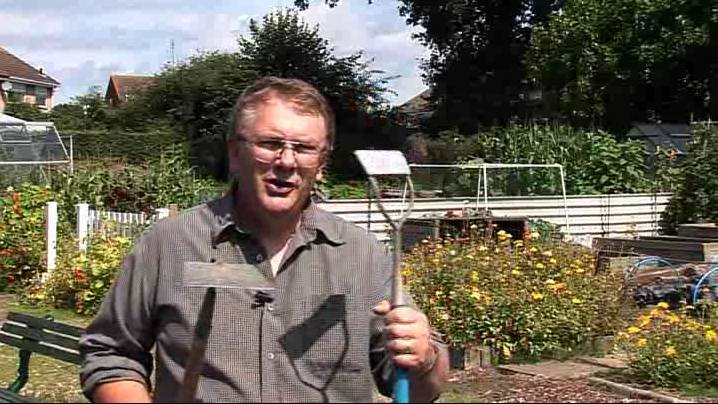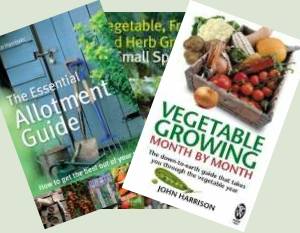 I was really surprised to find someone on our allotment using a Dutch hoe as if it was some sort of spade for digging up weeds so felt some explanation of different hoes and how to use them might be helpful.
I was really surprised to find someone on our allotment using a Dutch hoe as if it was some sort of spade for digging up weeds so felt some explanation of different hoes and how to use them might be helpful.
How to Use a Hoe – Types of Hoe
The Draw Hoe and the Dutch Hoe
The draw hoe is useful for making a shallow trench of the sort we might use for planting peas, which is why we call it drawing a trench, but for weeding I don’t think you can beat the Dutch hoes. The draw hoe just isn’t as easy or effective for weeding.
It’s really important to keep your Dutch hoe sharp, I’ve a metal file in the shed for this or you can use a sharpening stone. Just a few strokes every 10 minutes or so keeps it in optimum condition.The idea is to cut through the weed stem just below ground level. Blunt hoes or hoeing when the soil is wet tends to pull the weeds out with the roots intact. This means that if there is a drop of rain the weed will re-root and grow back. Hence my harping on about a sharp hoe! Sharp hoes are far more effective and easier to use than blunt hoes.



Hi, most garden centres will stock them or you could order on line. I’ve used Harrod Horticultural before and found the products and customer service to be good. Their hoes are here http://www.harrodhorticultural.com/garden-hoes-cid132.html?Aff=JHAG
Thank you so much John, I didn´t know a dutch hoe, now I will order one – have been turning my other hoe round, to have the same effect, for years but the angle of the dutch hoe looks as if it will be easier to work with.
Kind regards
Lise
Can you give me directions on sharpening a dutch ho r. I just bought a new one and there is no sharp edge. Do you sharpen the bottom or top of the hoe. Do you sharpen the back side also ? What angle do you use? Thanks for any help you can give me.
We’re not after a razor’s edge – just good enough for weeds. Using a file or stone on the top side to form an angle between 20 and 30 degrees I suppose.
It’s not exact. I do run once across the back to remove any burrs
I’ve recently been gifted an oscillating hoe. It’s fab for weeding
I really liked this video it was quite enjoyable and I am very glad as I know how to use a hoe now.
Thank you so much for the video. I used to pull weeds by hand but my back is now quite poor so I decided I ought to learn to hoe. Your demo was as clear as anything!! Now I can get rid of weeds without bending down.
I found this very useful. I use a very old dutch hoe and will now get myself something to sharpen it with, and use a slightly better technique in future. Thank you.
It might be useful for a series about different garden tools. For example there are several different types of spades and forks different shapes for different jobs though some seem to be different merely based on geography.
I enjoy using an old Dutch hoe, but have a new small onion hoe which was very blunt when I bought it, but useful for close working, but having both a sharpening stone and file must have a better go at sharpening it.
Your video, though useful shows your nice dry friable soil, but mine is heavy clay which either sets like a brick when dry or is clawpy when wet. Am I better hoeing when wet if we have a week’s rain or waiting for it to eventually dry?
That nice friable soil took 5 years work to make from heavy, ochre, solid, pottery making clay! 🙂
Better when dry if possible as there’s less chance of weeds re-rooting, surviving.
Hi, Is there an article somewhere about how you improved the soil please? I am a newbie with an allotment for one year, soil could definitely do with improvement, just not sure where to start. I’ve added manure this winter. What do I do next please?
That’s a big topic but basically add organic matter, work the soil is the main thing. I do cover the topic in more depth in chapter 2 of Vegetable Growing Month by Month
Hi Colin
I find adding a good thick layer of compost helps break up heavy clay
My favourite hoe at the moment comprises an old 12″ steel ruler bent into a U shape and attached to a 4ft long 2″ x 2″ piece of wood. It resembles an enlarged and much sturdier version of a tool sold as a “garden bandit”. It’s good for hoeing around smaller more delicate plants, as it’s used kneeling or bending over, though it can handle the rougher stuff reasonably well.
I was lucky enough to inherit an onion hoe from my grandfather via my father. It’s a bit smaller than it was a hundred years ago but still works fine! My father replaced the handle due to woodworm and I’ve bound it as it was starting to split. I think it’s paid for itself by now!
I love my onion hoe – my current favourite tool. It’s an incredibly sharp and easily resharpened short handled hoe, from Darlac, and unbelievably it came free with a large batch of onion sets. I use it close to all crops that are small enough, from parsnips to strawberries, ’cause I can hoe in the row as well as between, with max control.
My oscillating stirrup hoe from Quickcrop is the best tool I know of. I wouldn’t be without it.
I inherited a swoe, what a brilliant tool. It’s narrow enough to do the work of a Dutch hoe but so much easier and efficient around plants, without damaging them.
Good to watch this video and realise I’ve been using my dutch hoe all wrong for the past 30 years or so! Will make short work of the weeds in my veg patch now thank you!
Hello John.
I hope that the physio is working well for you.
I read a article about hoes many years ago, it stated that when using a push pull how have the how the same length as you are high. If to short they have a tendency to dig in. I use swoe I find that they are brilliant, it is almost the same length as I am high.
Hi John,
I’ve been using my Dutch Hoe wrong too!
Funnily enough sometimes at my allotment my hoe has wanted to do as you showed in your video!
Thank you so much. Video’s are so much easier to understand sometimes than reading.
Happy Hoeing John! ☺
Don’t forget the so-called onion hoe for working close to plants. My Darlac onion hoe is my absolute favourite tool, fast and effective (if you don’t mind bending). It too needs sharpening.